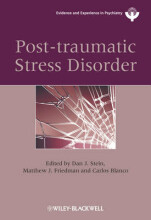Summary: Post-Traumatic Stress Disorder | 9780470688977
- This + 400k other summaries
- A unique study and practice tool
- Never study anything twice again
- Get the grades you hope for
- 100% sure, 100% understanding
Read the summary and the most important questions on Post-Traumatic Stress Disorder | 9780470688977
-
1 PTSD and Related Disorders
This is a preview. There are 13 more flashcards available for chapter 1
Show more cards here -
PTSD is a disorder of ___ rather than a disorder of ____
reactivity
altered baseline state -
traumatic stimuli activate the ____, which in turn produces outputs to the
Amygdala
hippocampus, medial prefrontal cortex, locus coeruleus, thalamus, hypothalamus, insula and dorsal/ventral striatum. -
alterations to DSM III PTSD criteria
- number possible symptoms increased (12-17)
- original three symptoms have been rearranged into present triad of reexperiencing, avoidance/numbing and hyperarousal).
- Criterion E (duration of symptoms must exceed one month) was included in DSM III-R in 1987 and Criterion F (symptoms must cause clinically significant distress or functional impairment) was added in DSM IV in 1994
- Criterion A no longer characterized as exposure to traumatic event, as an event that 'is generally outside the range of usual human experience' -
Does traumatic exposure cause PTSD :
Bearings on question:
- people differ in their vulnerability and resilience (most people do not develop PTSD)
- events differ with regard to conditional probability that PTSD will follow exposure
complex interaction between individual susceptibility and toxicity of a given stressful event
Criterion A1 is necessary but not sufficient condition for subsequent development of PTSD. There is a debate over how narrow criterion A1 should be. -
prototypical major negative events be rated objectively along 6 dimensions (proposed by Dohrenwind)
1) valence (negative)
2) source (external, uncontrollable, 'fateful')
3) unpredictable, central (life-threatening
4) deprivation of basic needs and goals)
5) magnitude (likelihood of causing great negative changes)
6) likelihood to exhaust the individual -
suggested modifications for criterion A1 from DSM IV to DSM V
- emphasizing temporal rather than anthological relationship between A1 and B-F symptoms
- narrowing the criterion to eliminate second hand exposure
- incorporating Dohrenwend's dimensional approach -
Criterion A in DSM V
adress concerns:
- reduce ambiguity surrounding what is and what is not a traumatic event (A1)
-> key question is whether to A1 should be designed to maximize sensitivity or whether it should maximize specificity
- increase utility criterion A2 in making PTSD diagnosis and whether 'fear, helplessness, or horror' should be expanded to include both peritraumatic dissociation and other intense peritraumatic emotions.
- elimination A2. -
3 symptom clusters in DSM IV PTSD construct
- B: reexperiencing
- C: avoidance/numbing
- D: hyperarousal -
proposal DSM V 4 symptom clusters
reexperiencing
avoidance
arousal and reactivity
negative alterations n cognitions and mood (replace DSM IV numbing cluster) -
people who meet ASD criteria are at ___ risk for developing PTSD. Majority of people who develop PTSD _____ ASD criteria
higher
have never met
partially explained by the fact that the re-experiencing, avoidance, and arousal ASD clusters are very similar to same clusters in PTSD, while most ASD dissociative symptoms are not found in PTSD
- Higher grades + faster learning
- Never study anything twice
- 100% sure, 100% understanding
































